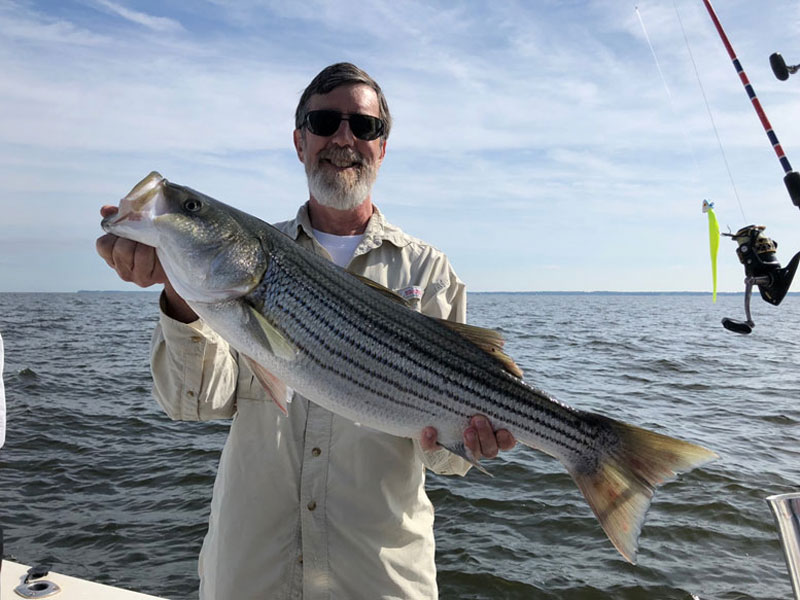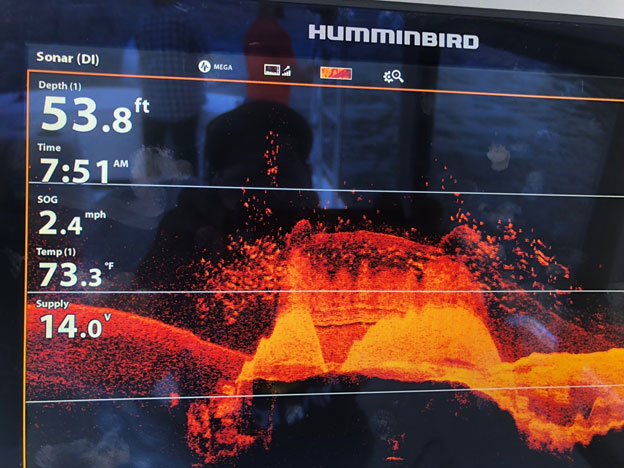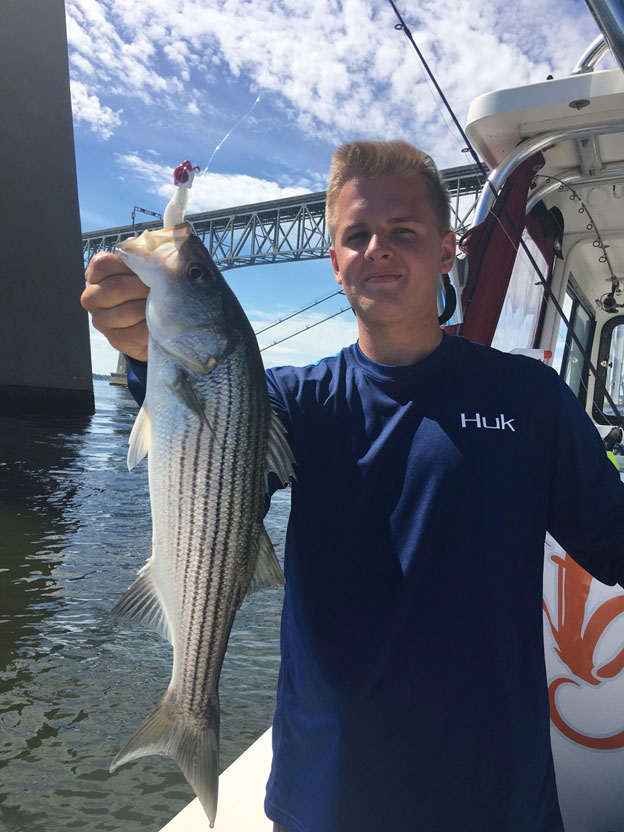Running around Chesapeake Bay as a light tackle guide who has never considered summer chumming, I have to produce all summer without ever slinging a scoop of chum or chunk of bait. Not that there’s anything wrong with fishing like that, it’s legal and produces fish for sure. Unfortunately, however, science declares that many undersize stripers caught and released die because of the high water temperatures we may have in August and some folks may want to come up with an alternative, productive, and rewarding technique to catch a limit of Chesapeake Bay rockfish. And on a bright note, while I’ve witnessed in my 15 years of full time guiding a huge decline in the numbers and range of stripers in Chesapeake Bay, we still catch plenty without anchoring up with the fleets and slinging chum.

My strategy for successfully locating and catching Striped Bass is simple: current plus structure equals fish – but not always. Factors like imitating the bait being eaten (matching the hatch), putting the bait you are throwing where the fish are located, and moving said baits through the water in a way which draws a strike are crucial.
Current + Structure = Fish
Striped Bass are predator fish who love to hang around areas where current is ripped around and over objects in the water, concentrating baitfish where they can easily be eaten. Obvious structures such as lighthouses and bridges create great current rips which may hold many predators at times. One thing I’ve learned for sure is they aren’t always on every structure. Moving from one structure point to another is crucial. I use my electronics and a strategically placed BKD to determine if a structure is holding fish or not.

This picture is a shot of large structure at the Chesapeake Bay Bridge, from last year. As I drifted silently over the structure I saw my fish finder record lots of activity below the boat and immediately had my anglers flip out a one-ounce skirted jig-head tipped with a six-inch Bass Kandy Delight. I told them to let it drop until they detected the “tick” of the bottom and then work the lure with short sharp twitches of the rod tip and some reeling to maintain a snug line up through the water column. The stripers in this screen shot were eating menhaden suspended around the structure. As the jigs were worked up through the water column they passed the suspended fish – and were attacked.
Just like at the Bay Bridge pilings, when tide is moving in or out on Chesapeake Bay every lighthouse has great current rips going around them. Shallow-water lighthouses and rockpiles like those off Sandy Point, Love Point, Thomas Point, and Bloody Point sometimes hold fish in the summer. (I wish always… but they just don’t always hold fish). Early morning or evening or overcast and rainy days produce more consistently on shallow-water lighthouses, but even in the middle of a hot summer day fish could be hanging around them.
If water depth is 10 feet or less I love throwing a Rapala X-Rap 12. Okay, so it’s not exactly a jig, but hear me out because it is effective. The technique I use is throwing it cross-current, then giving a very fast but erratic retrieve with the rod tip low to the water, reeling quickly with a stop-and-go pause with about a six-inch rod-tip twitch. It dives four to six feet, depending on how fast you retrieve it. Faster retrieves force it to dive deeper, while slowing it down results in it running shallower. Stripers cannot let this bait go without a strike if you’re near them. Positioning the boat a medium-length cast away from your target zone is effective, and is even more effective if you have a Minn Kota with Spot-Lock and can hold the boat in place even with a ripping current.
Another effective technique at shallow lighthouses is down-sizing to a half-ounce jighead and BKD, and throwing it cross-current near a lighthouse. Click your bail as soon as the jig hits the water, hold the rod up at a 45-degree angle, and maintain a snug line. If line is snug you will detect the “tick” of the jig hitting the bottom. At this point maintain the rod at a 45-degree angle and begin jigging the lure back to the boat across the current rip. Between each sharp twitch you should pause enough to allow the jig to maintain depth and maybe even tick bottom after every sharp twitch or two. The best guys using this technique always maintain a snug line while jigging, because without tension on the line you can’t detect the hit of a predator sucking in the jig – and working the jig back to the boat effectively is a technique that requires practice.

Keep in mind with every lure thrown, keeping the bait working erratically is crucial. Erratic attracts predators big-time. A steady slow retrieve in many cases doesn’t draw the attention. With that said, there is never an “always” in catching fish. Sometimes fish hit better on a slower retrieve in situation like after a major cold front. The key thing for me is if you see fish and they aren’t hitting, change something up. Change your retrieve, or maybe downsize your lure or jig head weight to inspire those finicky fish to bite.
Jigging Open Water
In the case of open water, rockfish will absolutely demolish a jig. For this scenario I like a one-ounce skirted jig head tipped with a six- or 10-inch BKD. Don’t let lure size scare you – if the fish are 22-inches and above they will hammer a 10-inch BKD. Certainly, other baits will work and if you see anything at the top throw out a nice Stillwater Smack’it or any favorite surface plug.
Using your fishfinder is very important in finding fish in open water. Schools of menhaden aren’t typically holding on structure, but may be out in waters 30-feet deep or more. Often they’re at the top, and on a calm day you can use binoculars to spot the quivering water and locate them if birds don’t give away their presence. Many times Stripers will be feeding down below, or nearby on menhaden suspended in the water column. This situation is when reading your fishfinder is critical.
Once fish are located, the technique I like here is to make a long cast, click the bail, and hold the rod at a 45-degree angle with a snug line while letting the jig drop through the water column. Sometimes it will get hit while dropping down, but if slack line is present you won’t feel the strike on the drop. Once your lure has reached the bottom start an aggressive retrieve with short, sharp twitches, and reel to maintain tension. Stop-and-go pause, and keep on retrieving.
From Sharps Island to Rock Hall, fish can be caught outside the chum slicks with no bait slinging necessary if you just use your fishfinder, chart, eyeballs, binoculars, and add in some practice. Catching Stripers on lures is a blast – so go on out and give it a shot this summer when the chumming fleets make chunks of the Bay look like a Walmart parking lot.
-By Captain Pete "Walleye" Dahlberg, Four Seasons Guide Service
You say that unlike Capt. Pete, you'd like to give summer chumming a shot this season? Be sure to check out Schoolie Stripers 101 - Summer Chumming: The Heat is On, in the Chesapeake Bay.